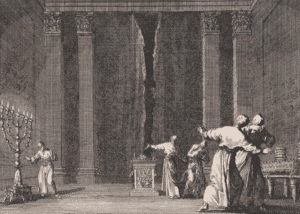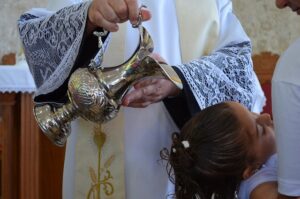Mormonism teaches that certain sacred ordinances carried out in temples are necessary for eternal life. To this end, the LDS church builds temples all over the world where these rites and rituals can be performed. Biblically, however, God never commanded the building of multiple temples and even the one temple God did ordain was fulfilled in Christ and is no longer needed. Today, God has only a living Temple made up of His people, not a temple of stone and metal made with human hands.
The temple, sacrifice, and God’s presence
In the Old Testament, God first introduces the concept of a sacred building in the covenant of Moses at mount Sinai. (Before this, in the times of Noah or of Abraham, Isaac, or Jacob, there was nothing remotely like a temple at all). When God instituted the Old Covenant with its laws, ceremonies, and sacrifices, the Israelites were commanded to build a Tabernacle which would be at the center of this worship. The Tabernacle represented the presence of God.
“Let them construct a sanctuary for me, that I may dwell among them,” (Exodus 25:8).
The language here implies that, without the Tabernacle, God could not dwell among His people. They were to build it “so that” God may dwell among them. Exodus goes on to explain this further. God could not dwell among the Israelites because of their sin. Thus, regular sacrifice was required to atone for their iniquity so that God may dwell among them:
“Now this is what you shall offer on the altar: two one year old lambs each day, continuously. The one lamb you shall offer in the morning and the other lamb you shall offer at twilight; and there shall be one-tenth of an ephah of fine flour mixed with one-fourth of a hin of beaten oil, and one-fourth of a hin of wine for a drink offering with one lamb. The other lamb you shall offer at twilight, and shall offer with it the same grain offering and the same drink offering as in the morning, for a soothing aroma, an offering by fire to the Lord. It shall be a continual burnt offering throughout your generations at the doorway of the tent of meeting before the Lord, where I will meet with you, to speak to you there. I will meet there with the sons of Israel, and it shall be consecrated by My glory. I will consecrate the tent of meeting and the altar; I will also consecrate Aaron and his sons to minister as priests to Me. I will dwell among the sons of Israel and will be their God. They shall know that I am the Lord their God who brought them out of the land of Egypt, that I might dwell among them; I am the Lord their God,” (Exodus 29:38-46).
In this way, the Tabernacle represented both God’s presence among the people and also their separation from Him. God’s presence was in their midst, but hidden behind a veil (discussed further below). Between this most holy place and the people were layers of ongoing blood sacrifice ever reminding them that no sin or impurity can come into the presence of God.
Later, in the time of King Solomon, the Tabernacle was replaced by a permanent Temple in Jerusalem. The purpose and meaning of this Temple remained the same as the Tabernacle it replaced:
“Now the word of the Lord came to Solomon saying, ‘Concerning this house which you are building, if you will walk in My statutes and execute My ordinances and keep all My commandments by walking in them, then I will carry out My word with you which I spoke to David your father. I will dwell among the sons of Israel, and will not forsake My people Israel,'” (1 Kings 6:11-13).
Of course, Mormon temples are not places of sacrifice nor centers of the kind of atoning rituals that were done according to the Mosaic law. But this is literally the very purpose for which the biblical Tabernacle/Temple was built! And this purpose was fulfilled in Christ:
“but He, having offered one sacrifice for sins for all time, sat down at the right hand of God, waiting from that time onward until His enemies be made a footstool for His feet. For by one offering He has perfected for all time those who are sanctified,” (Hebrews 10:12-14).
Jesus took away the need for animal sacrifices by offering a greater once-for-all atonement on the cross. In doing so, He made it possible for us to dwell in the presence of God without the separation of temple walls, courts, altars, and veils. The Temple was built so that God may “dwell among the sons of Israel”, but after the death and resurrection of Christ we are told:
“I am with you always, even to the end of the age” (Matthew 28:20),
Because of the finished work of Christ, God can dwell among His people without the need for the separation that a Temple implies.
The veil and God’s presence
Perhaps the most powerful symbol of the separation of God’s holy presence from His sinful people was the veil or curtain in the temple that separated the Holy of Holies (the central room in which God’s presence dwelt above the mercy seat of the ark of the covenant). Even the high priest could not simply enter this room whenever he wished:
“The Lord said to Moses: ‘Tell your brother Aaron that he shall not enter at any time into the holy place inside the veil, before the mercy seat which is on the ark, or he will die; for I will appear in the cloud over the mercy seat,” (Leviticus 16:2).
No one with any physical defect could even approach the veil nor serve at the altar or they would profane it (Leviticus 21:23) and “…the outsider who comes near shall be put to death,” (Numbers 18:7). Indeed, when the tabernacle was packed up to move from one place to another, even then the veil remained between God and the people:
“When the camp sets out, Aaron and his sons shall go in and they shall take down the veil of the screen and cover the ark of the testimony with it,” (Numbers 4:5).
 The veil was likewise before the holy of holies in Solomon’s temple, (2 Chronicles 3:14). It remained a constant reminder that people were not pure enough to truly enter into God’s presence. Yet, at Christ’s atoning death on the cross, that curtain in the temple was torn in two (Matthew 27:51, Mark 15:38, Luke 23:45), for the way had been opened for God’s people to enter cleanly into His presence, clothed in the righteousness of Christ. The Book of Hebrews again explains:
The veil was likewise before the holy of holies in Solomon’s temple, (2 Chronicles 3:14). It remained a constant reminder that people were not pure enough to truly enter into God’s presence. Yet, at Christ’s atoning death on the cross, that curtain in the temple was torn in two (Matthew 27:51, Mark 15:38, Luke 23:45), for the way had been opened for God’s people to enter cleanly into His presence, clothed in the righteousness of Christ. The Book of Hebrews again explains:
“Therefore, brethren, since we have confidence to enter the holy place by the blood of Jesus, by a new and living way which He inaugurated for us through the veil, that is, His flesh, and since we have a great priest over the house of God, let us draw near with a sincere heart in full assurance of faith, having our hearts sprinkled clean from an evil conscience and our bodies washed with pure water. Let us hold fast the confession of our hope without wavering, for He who promised is faithful,” (Hebrews 10:19-23).
Again, the need for temple walls and veils that separate us from the presence of God has been fully removed in Christ. Through His perfect sacrifice alone we can enter into God’s presence without the need to add our own rites and rituals to Jesus’ finished work.
Greater than the Temple: When God’s presence comes
The tabernacle and temple represented the unique dwelling of the presence of God among His people. Yet, at the coming of Christ, that presence walked among them in a new and greater dwelling not made of gold and stone. As John says:
“And the Word became flesh, and dwelt among us, and we saw His glory, glory as of the only begotten from the Father, full of grace and truth,” (John 1:14).
Not only does the language here of dwelling among us echo back to the language about the tabernacle and temple, but the very term used here for “dwelt” can literally be translated “tabernacled among us”1 Further, John’s statement that we “saw his glory” echoes the word of the Psalmist:
“I have seen you in the sanctuary and beheld your power and your glory,” (Psalm 63:2).
Just as the glorious cloud of God’s presence was seen in the Temple, even more did they see God’s presence when they looked upon Jesus in the flesh. In this one short verse, John virtually exhausts the phrases available to him with which to say that, what the Temple once was, Jesus had now become. Indeed, he would go on in John 2:21 to explicitly refer to the “temple of His body.” Yet again in John 4, when the Samaritan woman asked Jesus whether the Jews or the Samaritans had the right location for the temple, Jesus didn’t say “both, and there should be many more temples as well!” but rather, “an hour is coming when neither in this mountain nor in Jerusalem will you worship the Father,” (John 4:21), for:
“But an hour is coming, and now is, when the true worshipers will worship the Father in spirit and truth; for such people the Father seeks to be His worshipers,” (John 4:23).
The time of temple worship was at an end for, as Jesus Himself boldly proclaimed:
“But I say to you that something greater than the temple is here,” (Matthew 12:6).
And what of that one temple that God Himself really had established in Jerusalem? Jesus unambiguously pronounced its destruction:
“Jesus came out from the temple and was going away when His disciples came up to point out the temple buildings to Him. And He said to them, ‘Do you not see all these things? Truly I say to you, not one stone here will be left upon another, which will not be torn down,'” (Matthew 24:1-2, see also Mark 13:1-2, Luke 21:5-6).
A temple of men
But Jesus’ body ascended into heaven. Is there no temple left on earth at all? Actually, there is. It is not a building of brick and mortar made with human hands. It is, rather, the dwelling place of God’s presence. It is where His Spirit resides. It is a temple made of men and women redeemed by the blood of Christ. As Paul writes:
“Do you not know that you are a temple of God and that the Spirit of God dwells in you? If any man destroys the temple of God, God will destroy him, for the temple of God is holy, and that is what you are,” (1 Corinthians 3:16-17).
And again:
“Or what agreement has the temple of God with idols? For we are the temple of the living God; just as God said, ‘I will dwell in them and walk among them; And I will be their God, and they shall be My people,'” (2 Corinthians 6:16).
Thus, the true Christian has no need of man-made temples. We are the temple. God dwells in us and is with us now and forever, to the very end of the age.
References
| 1↑ | See Young’s Literal Translation, the Messianic Jewish “Tree of Life Version,” etc. |
|---|






